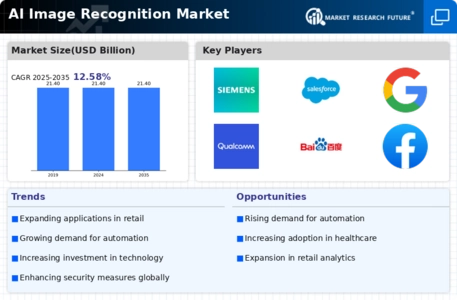Rising Demand for Automation
The AI Image Recognition Market experiences a notable surge in demand for automation across various sectors. Industries such as manufacturing, healthcare, and logistics increasingly adopt AI-driven solutions to enhance operational efficiency. For instance, the integration of AI image recognition in quality control processes allows for real-time defect detection, thereby reducing waste and improving product quality. According to recent data, the automation market is projected to grow at a compound annual growth rate of 9.5% through 2027, indicating a strong correlation with the AI image recognition sector. This trend suggests that as businesses strive for greater efficiency, the reliance on AI image recognition technologies will likely intensify, driving market growth.
Expansion of Mobile Applications
The AI Image Recognition Market is experiencing an expansion in mobile applications that leverage image recognition capabilities. With the proliferation of smartphones and mobile devices, businesses are integrating AI image recognition into their applications to enhance user experiences. For example, retail apps are utilizing image recognition for visual search functionalities, allowing consumers to find products by simply taking a picture. As of 2025, the mobile application market is expected to surpass 400 billion USD, indicating a substantial opportunity for AI image recognition technologies. This expansion suggests that as mobile usage continues to rise, the integration of AI image recognition will likely become more prevalent, driving market growth.
Increased Investment in AI Startups
The AI Image Recognition Market benefits from a surge in investment directed towards AI startups. Venture capitalists and private equity firms are increasingly recognizing the potential of AI technologies, leading to substantial funding for innovative companies in the image recognition space. In 2025, investments in AI startups are projected to exceed 50 billion USD, highlighting the growing confidence in AI-driven solutions. This influx of capital enables startups to develop cutting-edge technologies and applications, thereby expanding the overall market. As these startups introduce novel solutions, the competitive landscape of the AI image recognition market is likely to evolve, fostering innovation and growth.
Advancements in Deep Learning Technologies
The AI Image Recognition Market is significantly influenced by advancements in deep learning technologies. These innovations enhance the accuracy and speed of image recognition systems, making them more appealing to businesses. For example, convolutional neural networks (CNNs) have revolutionized image processing, allowing for more precise identification of objects and patterns. As of 2025, the deep learning market is expected to reach approximately 23 billion USD, reflecting a robust growth trajectory. This growth is likely to propel the AI image recognition market forward, as companies increasingly seek to leverage these advanced technologies to improve their products and services.
Growing Adoption in Security and Surveillance
The AI Image Recognition Market sees a growing adoption of image recognition technologies in security and surveillance applications. Organizations are increasingly utilizing AI-driven systems to enhance safety and security measures. For instance, facial recognition technology is being deployed in public spaces and private facilities to monitor and identify individuals. The AI Image Recognition is projected to reach 300 billion USD by 2026, with a significant portion attributed to AI image recognition solutions. This trend indicates that as security concerns rise, the demand for AI image recognition technologies will likely increase, further propelling market growth.

















Leave a Comment